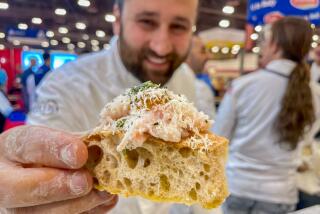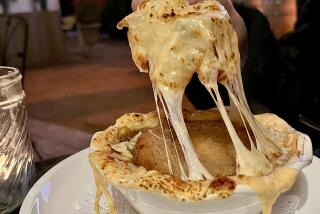Bean Soup With a Tuscan Touch
- Share via
What happens when an Italian language expert suddenly discovers that his avocation of cooking for friends is getting out of hand? Simple, if he’s Giuliano Bugialli. He simply gives up his career as a linguist and gives in to the inevitable, making a name for himself as a culinary expert and teacher who specializes in the foods of his Italian homeland. His switch in careers means Bugialli spends a lot of time on the road. He is the author of a number of cookbooks on Italian cooking and frequently travels throughout the United States promoting them and teaching classes at American cooking schools. In addition, he maintains a busy cooking school of his own in Florence. Fortunately for his survival, his energy is as boundless as his knowledge of the diverse art of Italian cookery. The Times caught up with him last week between classes at several different local cooking schools and extracted a recipe from him for a Tuscan soup he served to a food writer’s group visiting Florence last May. It was a memorable meal-in-one soup with delicious Italian overtones.
When word came that Giuliano Bugialli, one of Italy’s better known cooking teachers, was on one of his whirlwind cooking school tours to Southern California, it created a strong sense of deja vu in the heart of this writer. Bugialli teaches cooking classes as a visiting instructor all around this country, and has his own cooking school in Florence, Italy.
Less than a year ago I was among a group of newspaper food editors that he and Eleanor Ostman, food editor of the St. Paul (Minn.) Pioneer Press and Dispatch, led on a fast-paced, four-week tour of Italy.
Beginning in Palermo, Sicily, the tour introduced us to the remarkable diversity of Italian cooking. Within two days it became evident that we would live with full tummies and notebooks and increasingly weary brains for weeks to come. Determined that we weren’t to miss a single regional specialty, Bugialli rushed us from meal to meal, each one reflecting the way familiar and, surprisingly often, unfamiliar foods were prepared in that area. We learned quickly to limit the bites of whatever specialty was placed in front of us, no matter how good it was. There always was more to come . . . much more! As belt lines tightened, our curiosity and amazement grew.
Each time we crossed the boundaries from one region to another, it was as though we had entered a new country. And, of course, the food experts we visited were absolutely certain that the foods of no other region could quite match the perfection of theirs. They may not always have been right, but it soon became apparent that it was impossible to compare even such universal Italian specialties as pasta dishes. The pastas were different, the seasonings were different and even the choice of additional ingredients was different from region to region. Trying to compare pastas from the south of Italy with those of the north was foolish. Each had its own character that suited its particular district’s style of food preparation.
Whenever we stopped in a different area, Bugialli picked up a bottle of the favorite local olive oil. Some were heavy, deep green, unfiltered oils. Others were light, almost lemon-colored, very fruity oils. But, for the most part, they were used in different ways. Ways that were eminently suitable for the types of foods and the methods of preparation indigenous to the area.
By the time the group had laced the Italian boot as far as Bugialli’s hometown of Florence, he had a sufficient number of oils to merit a tasting.
We had found very shortly into our trip that Bugialli is a devoted Florentine who quite understandably compares the merits of the rest of his country to those of his sophisticated native habitat. Thus, it came as no surprise that he felt the lighter, fruitier oils of Tuscany really were the only ones worth using. Certainly they fit into this country’s current trend to lighter dining; however, there is a lot to be said for some of the heavier, earthier flavors of the Sicilian and southern Italian oils when one is preparing gutsier foods.
The tasting took place at Bugialli’s school in Florence, where he offers weeklong cooking sessions at various times during the year. He also is planning to lead a two-week tour this fall that will cover much of the same terrain in Sicily, Puglia and other nearby regions in the south of Italy that the food editors visited. For information on the classes in Florence as well as the tour, write to: Mrs. Bernard Berman, 2830 Gordon St., Allentown, Pa. 18104 or call (215) 435-2451.
For lunch the day the group visited Bugialli’s school, he served a typical Florentine soup, Tuscan Bean Soup With Wheat Berries. It was an unbelievably hearty concoction made with dried cannellini beans and soft wheat berries. And in equally typical Italian fashion, he topped each serving with a spoonful of olive oil. Tuscan, of course.
Taking time out last week during his busy schedule of local cooking classes at The Perfect Pan in Encinitas, The Epicurean Cooking School and Robinson’s in Beverly Hills and The Inner Gourmet school in Pasadena, Bugialli helped us reconstruct the soup recipe, American-style.
The dried cannellini beans called for in the original recipe are available at some Italian specialty markets, but it’s possible to substitute Great Northern beans by making some minor changes in the cooking method. Try as we did, however, we could find no soft wheat berries, which are readily available in Florence. However, we did find winter wheat berries at health food stores and, by soaking them overnight, found they made an acceptable substitute for the original ingredient.
This is the sort of sturdy soup that is superb for chilly evenings when you’re looking for comfort foods. Oh how I wish I’d had it a couple of weeks ago during the worst of our winter storms. Here is the adapted recipe. TUSCAN BEAN SOUP WITH WHEAT BERRIES
2 cups dried Great Northern beans
1 cup winter wheat berries
2 medium carrots, cleaned and chopped
1 medium red onion, chopped
1 large stalk celery, chopped
1 medium clove garlic, peeled and chopped
1/4 pound prosciutto or pancetta, diced
4 quarts cold chicken broth or water
Salt, pepper
8 to 10 teaspoons extra virgin olive oil
Soak beans and wheat berries in water in separate bowls 8 to 10 hours or overnight. Drain and rinse beans and place in 5- to 6-quart kettle. Add carrots, onion, celery, garlic, prosciutto and chicken broth. Bring mixture to boil, reduce heat, cover and simmer 1 1/2 hours or until beans are cooked and tender.
Place food mill over another kettle and pass mixture through mill, using disc with small holes. Place kettle over medium heat and bring to boil. Season to taste with salt and pepper. Reduce heat and simmer 5 minutes.
Drain and rinse wheat berries and add to kettle. Stir mixture to blend in berries. Cover and continue to simmer about 45 minutes, stirring occasionally, until wheat berries are very tender and some have popped open. Remove pan from heat and let rest 10 minutes. Soup will thicken upon standing. If becomes too thick, thin with additional broth or water. To serve, ladle into soup bowls and top each serving with 1 teaspoon olive oil. Makes 8 to 10 servings.
Note: Winter wheat berries are available in health food stores.
More to Read
Eat your way across L.A.
Get our weekly Tasting Notes newsletter for reviews, news and more.
You may occasionally receive promotional content from the Los Angeles Times.










